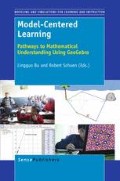Abstract
This chapter reports on the use of dynamic geometry to support the use of real world contexts to enhance the learning of mathematics in the middle secondary years. Dynamic geometry, either linked to real world images or used to create dynamic simulations, not only can provide opportunities for students to collect real or simulated data to make conjectures, but also can improve their understanding of mathematical concepts or relationships through exploration. Tasks, which access these features, can be valuable for both increasing students’ engagement and their depth of mathematical thinking. The colour, movement and interaction can create a halo effect valued by teachers for its impact on students’ general attitude towards studying mathematics.
Access this chapter
Tax calculation will be finalised at checkout
Purchases are for personal use only
Preview
Unable to display preview. Download preview PDF.
REFERENCES
Arcavi, A. & Hadas, N. (2000). Computer mediated learning: An example of an approach. International Journal of Computers for Mathematical Learning, 5 25–45.
Arzarello, F., Olivero, F., Paola, D., & Robutti, O. (2002). A cognitive analysis of dragging practices in Cabri environments. Zentralblatt für Didaktik der Mathematik. 34 (3) 66–72.
Blum, W., & Niss, M. (1989). Mathematical problem solving, modeling, applications, and links to other subjects – State, trends and issues in mathematics instruction. In W. Blum, M. Niss and I. Huntley (Eds.), Modelling, applications and applied problem solving. (pp 1–21). Chichester, UK: Ellis Horwood.
Bardini, C., Pierce, R. & Stacey, K. (2004) Teaching linear functions in context with graphics calculators: students’ responses and the impact of the approach on their use of algebraic symbols. International Journal of Science and Mathematics Education 2, 353–376.
Pierce, R. (2005). Linear functions and a triple influence of teaching on the development of students’ Algebraic Expectation In Chick, H. L. & Vincent, J. L. (Eds.). Proceedings of the 29th Conference of the International Group for the Psychology of Mathematics Education, Vol. 4, pp. 81–88. Melbourne: PME.
Burkhardt, H. (1981). The real world and mathematics. Glasgow, UK: Blackie
Henningsen, M., & Stein, M. K. (1997). Mathematical tasks and student cognition: Classroom-based factors that support and inhibit high-level mathematical thinking and reasoning. Journal for Research in Mathematics Education, 28, 524–549.
HREF1 RITEMATHS project website. Accessed 1st April 2009 from http://extranet.edfac.unimelb.edu.au/DSME/RITEMATHS/
Kaput, J. J. (1992). Technology and mathematics education. In D. A. Grouws (Ed.), Handbook of research on mathematics teaching and learning (pp. 515–556). New York: Macmillan.
Olivero, F. & Robutti, O. (2007). Measuring in dynamic geometry environments as a tool for conjecturing and proving. International Journal of Computers for Mathematical Learning. 12 135–156.
Pierce, R & Stacey, K. (2006). Enhancing the image of mathematics by association with simple pleasures from real world contexts. Zentralblatt für Didaktik der Mathematik. 38(2) 214–225.
Pierce, R., Stacey, K., & Ball, L. (2005). Mathematics from still and moving images. Australian Mathematics Teacher. 61(3), 26–31.
Stacey, K. (2008). Pedagogical Maps for Describing Teaching with Technology. Sharing inspiration 2008. Retrieved 29th April 2009 from http://www.sharinginspiration.org/info/contributions.php?lang=en&size=normal
Stacey, K. & Price, E. (2005). Surds, spirals, dynamic geometry and CAS. In J. Mousley, L. Bragg & C. Campbell (Eds.), Mathematics – Celebrating Achievement. Proceedings of 2005 MAV conference. (pp 298–306) Melbourne, Australia: Mathematical Association of Victoria.
Sinclair, M. (2003). Some implications of the results of a case study for the design of pre-constructed, dynamic geometry sketches and accompanying materials. Educational Studies in Mathematics. 52, 289–317.
Thorndike, Edward L. (1920). A constant error in psychological ratings. Journal of Applied Psychology. 4 25–29.
Vincent, J. (2007). Shrine to university: A geometry journey along St. Kilda Road and Swanston Street. Melbourne, Australia: Mathematical Association of Victoria.
Author information
Authors and Affiliations
Editor information
Editors and Affiliations
Rights and permissions
Copyright information
© 2011 Sense Publishers
About this chapter
Cite this chapter
Pierce, R., Stacey, K. (2011). Using Dynamic Geometry to Bring the Real World Into the Classroom. In: Bu, L., Schoen, R. (eds) Model-Centered Learning. Modeling and Simulations for Learning and Instruction, vol 6. SensePublishers. https://doi.org/10.1007/978-94-6091-618-2_4
Download citation
DOI: https://doi.org/10.1007/978-94-6091-618-2_4
Publisher Name: SensePublishers
Online ISBN: 978-94-6091-618-2
eBook Packages: Humanities, Social Sciences and LawEducation (R0)


